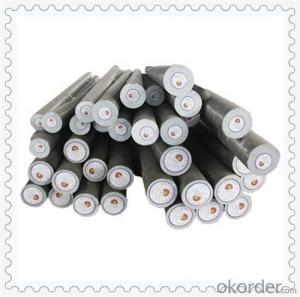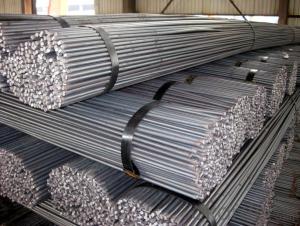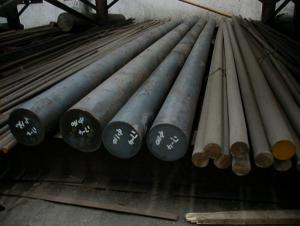Hot Rolled Alloy Structural Steel Round Bar SCM435
- Loading Port:
- China main port
- Payment Terms:
- TT OR LC
- Min Order Qty:
- 30 m.t.
- Supply Capability:
- 10000 m.t./month
OKorder Service Pledge
OKorder Financial Service
You Might Also Like
Hot Rolled Alloy Structural Steel Round Bar SCM435
Products Description
Material: | 30CrMoV, 4135, SCM435, 34CrMo4, 1.7220 |
Diameter: | 10mm-700mm |
Length: | 3000mm-12000mm Straightness: 3mm/M max |
Process: | EAF + LF + VD + Forged + Heat Treatment (optional) |
Delivery condition: | Hot forged +Rough machined (black surface after Q/T)+ Turned (optional) |
Delivery Time: | 30-45 days |
MOQ: | 1 tons |
Heat treatment: | Normalized / Annealed / Quenched / tempered |
Technical Data: | According to the customer's requirement of Chemical Composition, Physical Properties and Mechanical Testing |
Test: | Ultrasonic test according to SEP 1921-84 G3 C/c |
Marking: | Grade, heat NO. length will be stamped one each bar with required color |
Payment: | 30% advance by T\T, the balance against B/L |
Application: | Statically and dynamically stressed components for vehicles, engines and machines. For parts of larger cross-sections, crankshafts, gears. |
Products Show

Product Overviews
| Product Name | Typical Grades | Diameter(mm) | Standard adopted |
| Carbon Steel | 20 (1020/S20C/C22) | Ø16-Ø300 |
GB/SAE/JIS/DIN
|
| 40 (1040/S40C/C40) | |||
| 45 (1045/S45C/C45) | |||
| Bearing Steel | GCr9 (51100/SUJ1) | Ø12-Ø250 | |
| GCr15 (52100/SUJ2/100Gr6) | |||
| GCr9SiMn (A485-Gr.1/SUJ3) | |||
Cr-Mo Steel | 20Cr (5120/SCr420H/20Cr4) | Ø12-Ø250 | |
| 40Cr (5140/SCr440/41Cr4) | |||
| 42CrMo(4140/SCM440/42CrMo4) | |||
| Gear Steel | 20CrNiMo | Ø16-Ø600 | |
| 20CrMn(5115/SMnC420/20MnCr5) | |||
| 20CrNiMo(8620/SNCM220/20CrMiMo2) |
Application
| Carbon Steel | Mold bottom, Plastic mold, Construction machinery parts Automobile parts, Security grills, Screens, Construction |
| Bearing Steel | Aerospace, Navigation, Nuclear energy, Chemical industry Electronic information, Petrochemical, Instrument and meter Transportation |
| Cr-Mo Steel | Mechanism & Fasteners gear, Stressed components for vehicles Engines and machines, Parts of larger cross-section |
| Gear Steel | All kinds of gears, Statically and dynamically stressed component for vehicles Engines and machine, Larger cross-section parts, Crankshafts |
Work Shop

Company Information
CNBM International Corporation is the most important trading platform of CNBM group.
Whith its advantages, CNBM International are mainly concentrate on Cement, Glass, Iron and Steel, Ceramics industries and devotes herself for supplying high qulity series of refractories as well as technical consultancies and logistics solutions.


FAQ
1, Your advantages?
professional products inquiry, products knowledge train (for agents), smooth goods delivery, excellent customer solution proposale
2, Test & Certificate?
SGS test is available, customer inspection before shipping is welcome, third party inspection is no problem
3, Factory or Trading Company?
CNBM is a trading company but we have so many protocol factories and CNBM works as a trading department of these factories. Also CNBM is the holding company of many factories.
4, Payment Terms?
30% TT as deposit and 70% before delivery.
Irrevocable L/C at sight.
5, Trading Terms?
EXW, FOB, CIF, FFR, CNF
6, After-sale Service?
CNBM provides the services and support you need for every step of our cooperation. We're the business partner you can trust.
For any problem, please kindly contact us at any your convenient time.
We'll reply you in our first priority within 24 hours.
Packaging & Delivery
1, Packaging: seaworthy package or as required
2, Delivery: 35-45 days or based on quantity

- Q:How are steel round bars inspected for quality?
- Steel round bars are inspected for quality through various methods to ensure that they meet the required standards. The inspection process typically involves both visual examination and testing procedures. Visual inspection is the first step in assessing the quality of steel round bars. Qualified inspectors visually examine the bars for surface defects such as cracks, scratches, dents, or any other irregularities that may affect the structural integrity or performance of the bars. Additionally, dimensional inspection is conducted to verify the diameter, length, straightness, and overall shape of the round bars. This is done using precision measuring instruments to ensure that the bars meet the specified tolerances and requirements. Aside from visual inspection, various testing methods are employed to evaluate the mechanical properties and chemical composition of the steel round bars. The most common testing procedures include: 1. Tensile Testing: This test measures the strength and ductility of the steel bars by subjecting them to tension until they fracture. It helps determine the ultimate tensile strength, yield strength, and elongation of the material. 2. Hardness Testing: It is performed to assess the hardness of the steel round bars, which is an indicator of its resistance to deformation or wear. The most commonly used methods for hardness testing are Rockwell, Brinell, and Vickers hardness tests. 3. Ultrasonic Testing: This non-destructive testing method uses high-frequency sound waves to detect any internal defects or discontinuities in the steel bars. It helps identify flaws such as cracks, inclusions, or voids that may negatively impact the material's quality. 4. Chemical Analysis: Steel round bars undergo chemical analysis to determine the chemical composition and ensure it meets the required specifications. This analysis helps verify the percentages of different alloying elements present in the steel, ensuring it has the desired properties. All these inspection methods are conducted by trained professionals or certified third-party inspectors who are knowledgeable about the specific industry standards and guidelines. By combining visual examination and precise testing techniques, the quality of steel round bars can be thoroughly assessed, ensuring they are fit for their intended applications.
- Q:Are steel round bars suitable for the manufacturing of shafts?
- Yes, steel round bars are suitable for the manufacturing of shafts. Steel round bars are known for their strength, durability, and ability to withstand heavy loads and high rotational speeds, making them ideal for shaft applications. The round shape of the bar promotes uniform stress distribution, reducing the risk of failure or deformation. Additionally, steel round bars can be easily machined and heat-treated to achieve desired mechanical properties, such as hardness and toughness, further enhancing their suitability for shaft manufacturing. Overall, steel round bars offer the necessary characteristics required for shafts, making them a reliable and commonly used material in various industries.
- Q:Can steel round bars be used in structural applications?
- Steel round bars are suitable for structural applications and commonly utilized in construction and engineering projects that prioritize strength and durability. They offer versatility and can function as beams, columns, and supports for various structural elements. Thanks to their exceptional mechanical properties, such as high tensile strength and good ductility, they can withstand heavy loads and resist deformation effectively. Moreover, their easy joinability to other structural components contributes to their popularity within the construction industry.
- Q:Are steel round bars suitable for heat exchanger applications?
- Heat exchanger applications can benefit from the use of steel round bars. Steel is a widely utilized material in various industries, including heat exchangers, because of its exceptional thermal conductivity and strength. The round shape of the bars simplifies their fabrication and installation in heat exchanger systems. For applications requiring heat exchange, like power plants, chemical processes, HVAC systems, and refrigeration units, steel round bars are ideal as they efficiently transfer heat between two fluids. Moreover, steel provides good corrosion resistance, which is crucial for heat exchangers that encounter different fluids. By implementing proper design and material selection, steel round bars can reliably withstand high temperatures and pressure differentials in heat exchanger applications.
- Q:What are the typical dimensions of a steel round bar?
- The typical dimensions of a steel round bar can vary depending on the specific application and industry requirements. However, in general, steel round bars are commonly available in diameter sizes ranging from 1/4 inch to 24 inches. These dimensions are often measured in increments of 1/8 inch or 1/4 inch. The length of a steel round bar is typically standardized at 20 feet, although shorter lengths may also be available. It is important to note that these dimensions can vary significantly depending on the specific grade and type of steel being used, as well as the manufacturing process. Therefore, it is essential to consult the appropriate industry standards or consult with a supplier to determine the exact dimensions needed for a particular project.
- Q:Can steel round bars be used for making cutting tools?
- Yes, steel round bars can be used for making cutting tools. Steel is a versatile material that can be hardened and tempered to create sharp and durable cutting edges. Round bars can be machined and shaped into various cutting tool profiles such as drills, lathe tools, milling cutters, and punches. The specific type of steel used will depend on the desired cutting application, as different steel alloys have different properties such as hardness, toughness, and wear resistance. Heat treatment processes like quenching and tempering can further enhance the cutting performance and longevity of the tools. Overall, steel round bars provide a reliable and cost-effective option for manufacturing cutting tools.
- Q:What are the different types of defects that can occur in steel round bars?
- Steel round bars can experience a range of defects that differ in severity and impact on overall quality and performance. Common types of defects include surface defects, internal defects, dimensional defects, decarburization, lamination, and incomplete heat treatment. Surface defects, such as scratches, pits, and scaling, are visible on the external surface of the bar. While these defects may not compromise the bar's structural integrity, they can affect its aesthetic appeal and potentially lead to corrosion if not addressed properly. Internal defects, like voids, inclusions, and segregation, occur within the body of the bar. These defects can weaken the bar's mechanical properties, jeopardize its structural integrity, and even cause cracking or failure under stress. Dimensional defects refer to variations in the size or shape of the bar, such as differences in diameter, length, or straightness. These defects can occur during manufacturing and can impact the bar's functionality and compatibility with other components. Decarburization is a defect that arises when the surface layer of the bar loses carbon due to exposure to high temperatures during manufacturing or heat treatment. This defect weakens the bar's hardness and strength, making it more susceptible to wear, fatigue, or failure. Lamination defects occur when there are layers or separations within the bar, often resulting from inadequate rolling or processing techniques. These defects reduce the bar's strength and ductility, making it prone to fracture or failure. Incomplete heat treatment can occur if the process is not performed correctly or if there are inconsistencies in cooling or reheating. This can lead to variations in hardness, strength, or toughness along the length of the bar. Manufacturers and quality control teams employ various testing and inspection methods to detect and mitigate these defects, ensuring that the bars meet the necessary standards and specifications. It is crucial to consider the specific application and requirements of the steel round bar when assessing the severity and impact of these defects.
- Q:Can steel round bars be coated or plated?
- Steel round bars can indeed be coated or plated, which is a prevalent method employed to augment the functionality and visual appeal of steel products. Numerous choices exist for coating and plating, including zinc plating, chrome plating, nickel plating, and powder coating. These procedures offer added defense against corrosion, enhance durability, and create the desired aesthetics for the steel. The selection of the appropriate coating or plating technique hinges upon the particular application and specifications of the steel round bars.
- Q:What are the common defects found in steel round bars?
- Some common defects found in steel round bars include surface cracks, internal voids, inclusions, segregation, and dimensional variations. Surface cracks can occur during the manufacturing process or due to improper handling and transportation. These cracks can weaken the structural integrity of the bar and reduce its load-bearing capacity. Internal voids, also known as blowholes or cavities, are void spaces within the steel that can be caused by trapped gases during the solidification process. These voids can negatively impact the mechanical properties of the bar and make it more susceptible to failure under stress. Inclusions are non-metallic particles or impurities that can be present in the steel. They can originate from the raw materials used in the production or from contaminants during the manufacturing process. Inclusions can reduce the strength and ductility of the steel and can become initiation sites for cracks. Segregation refers to the uneven distribution of elements within the steel. It can occur during the solidification process, resulting in areas of the bar with different chemical compositions. This can lead to variations in mechanical properties such as hardness and toughness, making the bar less consistent in its performance. Dimensional variations, such as out-of-roundness or variations in diameter, can also be considered defects. These variations can affect the fit and functionality of the bar in applications where precise dimensions are critical. It is important to identify and address these defects to ensure the quality and reliability of steel round bars, especially in applications where high strength and performance are required. Regular inspections, quality control measures, and adherence to industry standards and specifications can help minimize these defects and ensure the integrity of the steel round bars.
- Q:Can steel round bars be used in the automotive parts industry?
- Yes, steel round bars can be used in the automotive parts industry. They are commonly used in the manufacturing of various automotive components such as axles, drive shafts, suspension systems, and chassis parts. The high strength and durability of steel make it an ideal material for these applications, ensuring the safety and reliability of vehicles.
1. Manufacturer Overview |
|
|---|---|
| Location | |
| Year Established | |
| Annual Output Value | |
| Main Markets | |
| Company Certifications | |
2. Manufacturer Certificates |
|
|---|---|
| a) Certification Name | |
| Range | |
| Reference | |
| Validity Period | |
3. Manufacturer Capability |
|
|---|---|
| a)Trade Capacity | |
| Nearest Port | |
| Export Percentage | |
| No.of Employees in Trade Department | |
| Language Spoken: | |
| b)Factory Information | |
| Factory Size: | |
| No. of Production Lines | |
| Contract Manufacturing | |
| Product Price Range | |
Send your message to us
Hot Rolled Alloy Structural Steel Round Bar SCM435
- Loading Port:
- China main port
- Payment Terms:
- TT OR LC
- Min Order Qty:
- 30 m.t.
- Supply Capability:
- 10000 m.t./month
OKorder Service Pledge
OKorder Financial Service
Similar products
New products
Hot products
Related keywords


































